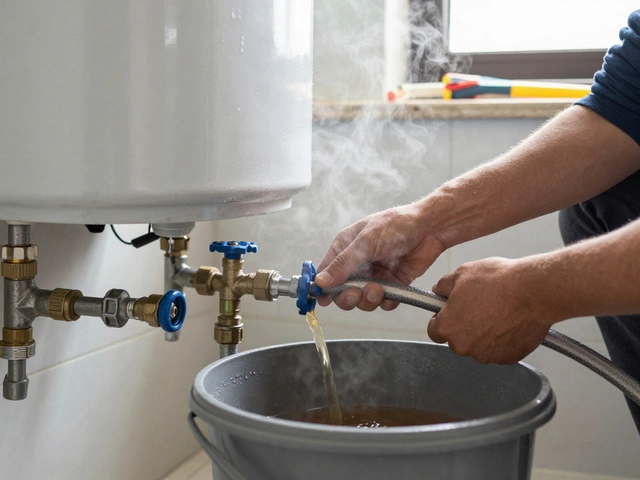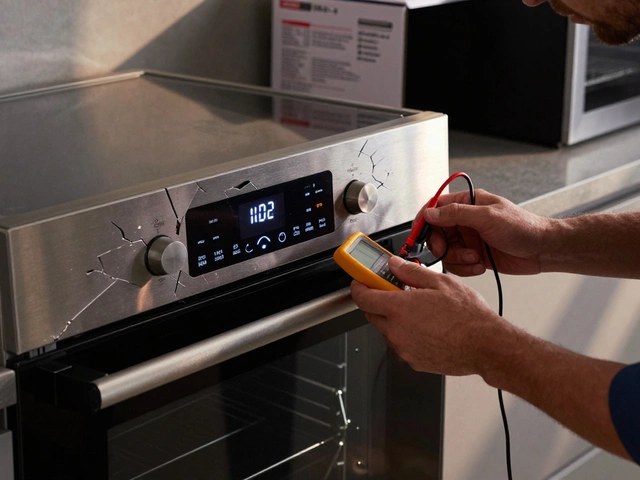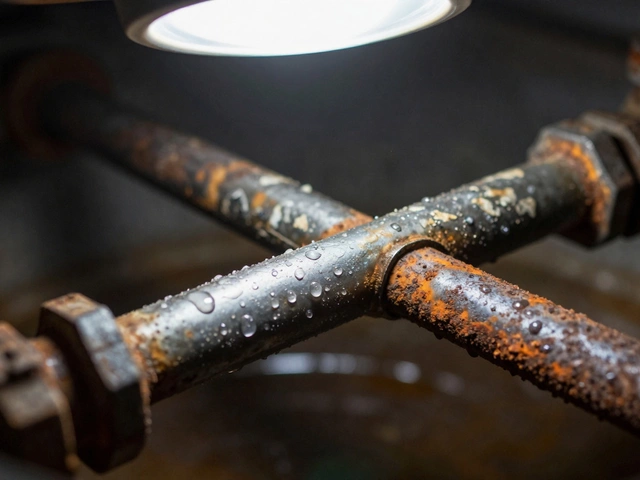So, your oven's not heating up like it used to, huh? It's probably time to look at the heating element. Common as they may be, these issues are often a straightforward fix, especially if you know what you're getting into cost-wise. Let's not sugarcoat it; understanding the cost of replacing a heating element can make the difference between a quick fix and a costly mistake.
Now, depending on whether you tackle this yourself or call in a pro, you're looking at spending anywhere from $20 to $200. Yeah, that's quite a range! If you’re handy with tools and feeling brave, the price leans towards the lower end. If not, professional repair services aren’t the cheapest and might inch that number closer to $200.
- Understanding Heating Element Costs
- DIY vs. Professional Replacement
- Factors Affecting the Cost
- Where to Find Affordable Parts
- Tips for a Successful Replacement
- When to Call a Professional
Understanding Heating Element Costs
Diving into the costs of replacing a heating element can feel a bit overwhelming at first, but stick with me here. The expenses you're likely to face depend on a few important factors, like the type of oven you have and whether you opt for a DIY fix or hire a professional.
First things first, let's talk parts. The average price for a new oven heating element ranges from $20 to $80. If your oven is on the newer side or has a fancy design, expect to pay closer to the upper range. Why the price difference? It’s all about the brand and availability. Authentic parts may cost more, but they're usually more reliable.
Considering doing it yourself? Great call for those looking to save a buck and are comfortable with a bit of handiwork. You’ll just need a few basic tools and a replacement part. Besides the part itself, there’s a chance you might have to shell out a bit for tools if you don’t already have what you need.
Here’s a quick breakdown of what you might spend:
- Heating Element: $20-$80
- Tools: $10-$30 (if you need extras)
Alternatively, bringing a pro into the picture tends to raise costs. Professional services usually range from $100 to $200, covering both parts and labor. Want it done right without lifting a finger? This might be your route. But remember, even small repairs can stack up on the bill.
Looking to trim costs? Shop around online or hit up local appliance stores for deals on electric oven repair parts. Who doesn’t love a bargain, right?
Good news is, investing time in understanding these costs upfront can save you bucks in the long run. Knowing whether to go DIY or call for help could be the game changer in your repair journey.
DIY vs. Professional Replacement
If you’re standing in your kitchen contemplating whether to roll up your sleeves or pick up the phone, you’re not alone. Deciding between fixing the oven heating element yourself or hiring a pro mainly boils down to cost, confidence, and time.
Going the DIY route can save you a good chunk of cash. If you’re reasonably handy, you might find the whole process quite satisfying. Most heating elements are plug-and-play, and you can find plenty of step-by-step guides and videos online. Here’s a quick rundown of what you need to do:
- Turn off the power to the oven from the circuit breaker.
- Remove the screws holding the faulty element using a screwdriver.
- Disconnect the wires carefully, noting where each one goes.
- Connect the new heating element's wires in the same positions.
- Screw the new element into place.
- Turn the power back on and test your oven.
Simple enough, right? If all those steps make you sweat, hiring a professional is a wise choice. Pros usually charge between $100 and $200 for labor, depending on your location and the complexity of your oven. They come armed with the tools and know-how, taking the stress and guesswork off your plate.
A professional repair is particularly sensible if your oven’s model is intricate or if you're unsure about handling live electricity. Mistakes with an oven repair could lead to safety hazards or more costly damages.
Ultimately, your choice might hinge on how much you value peace of mind versus your willingness to learn. Either way, whether you’re saving dollars with a DIY or stressing less with a professional, you’ll have your oven humming again sooner rather than later.
Factors Affecting the Cost
Alright, let's break down what goes into the price of replacing an oven's heating element. It's not just about the part itself; there's a whole bunch of stuff that can add a few bucks here and there.
First, the type of oven you're working with plays a huge role. Older models tend to have cheaper parts, but they can be trickier to find. Newer models might have parts that are readily available but could be pricier. Brands like GE, Whirlpool, or Samsung might have different pricing due to brand-specific designs.
Then, there's the availability of the heating element. If your oven’s model is rare or discontinued, finding a specific element might be like finding a unicorn. The more scarce the part, the higher the price. Popular models with elements sold all over might save you some cash.
Another factor is whether you do it yourself or hire a professional. DIY saves labor costs, but keep in mind, if you’re not confident in your repair skills, you could end up doing more harm than good.
Don't forget about location. If you live in a bustling city where appliance parts are readily stocked, costs can be lower. But if you're in a remote area, shipping fees for ordering online could hike up that price tag.
Lastly, consider any warranties. If your oven is still under warranty, you might get away with lower costs or even a free replacement. Check those warranty papers before reaching for your wallet.
Pulling all these factors together, you get the complete picture of what the oven repair cost might look like. It's always wise to compare a few different suppliers and maybe even get a couple of quotes from professionals to see where you stand financially.

Where to Find Affordable Parts
So, you're all set to swap out that busted heating element but don’t want to break the bank, right? Well, the good news is there are loads of places to score affordable parts for your oven. Whether you're a fan of clicking through websites or prefer to browse aisles in person, you've got options.
Online retailers like Amazon and eBay often have a wide range of electric oven parts, including heating elements. These platforms are great for comparing prices and reading user reviews before making a decision. Plus, they usually have generous return policies just in case you end up with the wrong part.
For those who lean towards the old-school way, local appliance repair shops or chain stores like Home Depot and Lowe's are solid bets. These stores not only carry essential parts, but their staff can offer guidance on what might suit your specific oven model. Sometimes, speaking to someone in-person can save you from a wrong purchase.
If you're keen on second-hand options, check out Facebook Marketplace or local buy-and-sell groups. People often sell parts from older ovens that are still in good shape, often for a fraction of the cost. It’s a bit of a treasure hunt but can yield big savings.
Whatever route you choose, always double-check the part number. You don’t want to end up with something that doesn’t fit your oven. Save yourself the frustration by bringing your old element to the store or pulling up your oven's specs while shopping online.
Tips for a Successful Replacement
When you decide to replace the heating element in your oven, being prepared is key. Here are some handy tips to ensure you get it right the first time:
1. Safety First
Before you even think about touching anything, make sure that oven's unplugged. A little shocking surprise is not the kind of excitement anyone needs in their kitchen.
2. Model Matters
Jot down your oven's model number. Sounds obvious, but you’d be surprised. Not all heating elements are the same, and knowing your model helps you avoid buying the wrong one.
3. Gather Your Tools
Having the right tools is half the battle. Grab a screwdriver and possibly a wrench, depending on how your element is fastened. Trust me; a butter knife isn't an adequate substitute.
4. Remove and Replace
- Remove: After ensuring safety, unscrew the old element carefully. It may have some wires connected, so take it slow.
- Install New: Slide in the new one, reconnect any wires, and secure it firmly with screws.
Be gentle with those connections; you don't want to end up fixing more than just the element.
5. Test It Out
Plug your oven back in and fire it up to see if it's heating correctly. If it ramps up as expected, you're golden. If not, you might need to double-check those connections.
Bonus Tip: Keep the Manual Handy
Your oven's manual is your best friend here. It often has diagrams and troubleshooting tips that can make what seems complex much simpler.
Armed with this info, you're all set for a smooth oven repair, making this fix less intimidating and more of a personal victory.
When to Call a Professional
Alright, not everyone is a born handyman, and that's totally okay! When it comes to something as important as your oven, sometimes bringing in a pro is the smart move. Let’s break down when it’s best to leave this job to the experts.
First off, if you've got a high-end or commercial-grade oven, these beasts can be as complicated as trying to do calculus without a calculator. The parts can be expensive, and a small mistake can cost you way more than hiring a professional. In these cases, calling in someone with expertise in oven repair is probably your best bet.
Next up, if troubleshooting isn’t your thing, and pulling the oven apart makes you break into a cold sweat, it’s time to dial that repair service. A professional will not only know how to handle the heating element with ease but will also ensure it's installed safely. Messing up electrical components can be tricky business.
Another scenario is when you've tried to tackle the heating element replacement yourself, but something just feels off. Maybe it's not heating evenly or at all. It’s easy to overlook small details that can have big impacts, like loose connections or wrong parts. A pro can diagnose and fix these issues right the first time.
Also, let’s face it—time is money. If you’ve got a schedule tighter than a drum, and every hour counts, sometimes it's just worth the cost to get the job done quickly and correctly by a professional. They can often get it sorted in an hour or two, while it might take you a whole Saturday.
Lastly, if any warranty covers your appliance, tampering with the electrical parts might void it. Check the warranty details. Many cover professional repairs, and it might save you some bucks.
Electric oven repair might seem straightforward, but knowing when to call in a professional can save you time, stress, and even money in the long run. Plus, it's always good to have peace of mind knowing that your appliance has been handled correctly.









